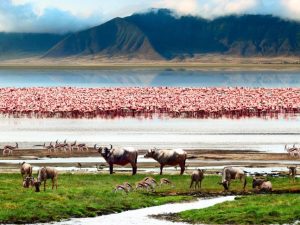The Formation of Ngorongoro Crater: A Geological Insight
The Ngorongoro Crater, located in Tanzania, is a breathtaking natural wonder that attracts tourists from all over the world. This natural wonder was formed millions of years ago through a series of geologic processes that have shaped the landscape into what we see today. Let’s take a closer look at how the Ngorongoro Crater came to be.
The Origin of Ngorongoro Crater
The Ngorongoro Crater is actually a large volcanic caldera, which is a collapsed volcanic crater. The caldera was formed millions of years ago when a massive volcano erupted and then collapsed in on itself, creating a large depression in the earth’s surface. This collapse resulted in the formation of the Ngorongoro Crater as we know it today.
The volcano that formed the Ngorongoro Crater was once one of the tallest mountains in Africa, towering over the surrounding landscape. However, after the eruption and subsequent collapse, the mountain was reduced to a fraction of its former size, leaving behind the caldera that we see today. The walls of the crater rise to heights of over 2,000 feet, enclosing a vast expanse of grasslands, forests, and wildlife.
Geologic Processes at Work
The geologic processes that shaped the Ngorongoro Crater did not end with the formation of the caldera. Over millions of years, the crater has been further shaped and molded by various forces of nature, including erosion, volcanic activity, and tectonic movements.
Erosion has played a significant role in sculpting the landscape of the Ngorongoro Crater. The crater is home to a number of rivers and streams that flow through its interior, cutting through the rock and soil and shaping the land over time. The constant movement of water has created valleys, gorges, and cliffs within the crater, adding to its dramatic and diverse topography.
Volcanic activity has also continued to impact the Ngorongoro Crater over the years. While the original volcano that formed the caldera is no longer active, there are still signs of volcanic activity within the crater. Geothermal springs can be found within the crater, releasing hot water and steam into the air. These springs are evidence of the continued geologic activity that is shaping the landscape of the Ngorongoro Crater.
Tectonic movements, such as earthquakes and shifting of tectonic plates, have also played a role in shaping the Ngorongoro Crater. These movements have caused the land within the crater to shift and change over time, creating new formations and altering the terrain in subtle ways.
In conclusion, the Ngorongoro Crater is a remarkable natural wonder that was formed through a combination of volcanic activity, erosion, and tectonic movements. Its unique geology and diverse landscape make it a must-see destination for any traveler visiting Tanzania. For those looking to experience the wonders of the Ngorongoro Crater firsthand, Sunset Africa Safari offers guided tours of the area. For booking inquiries, please contact info@sunsetafricasafari.com.


